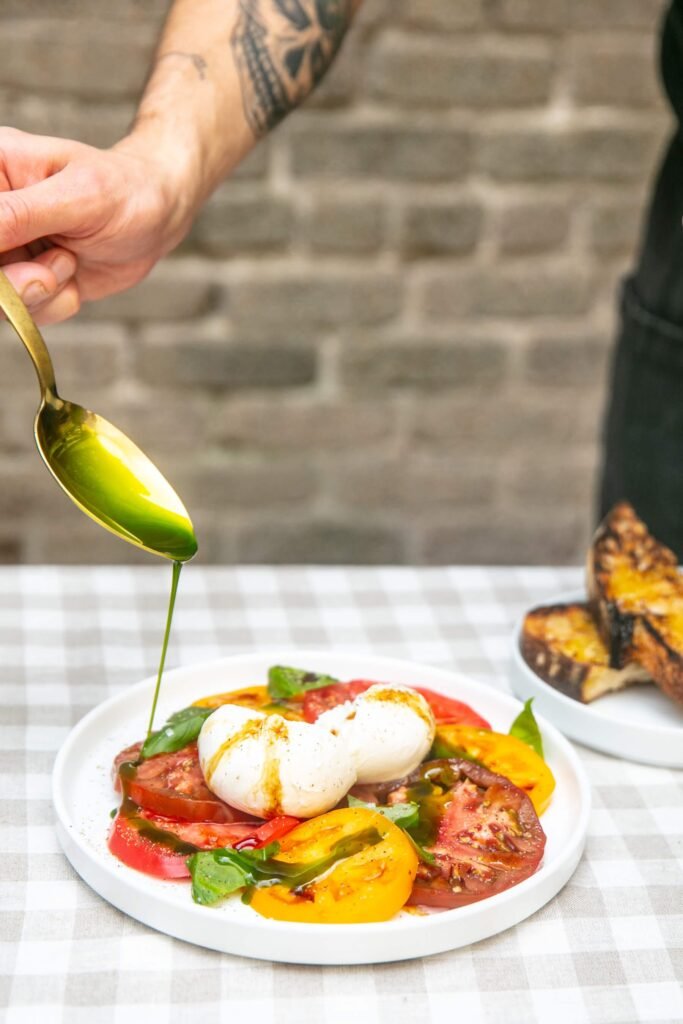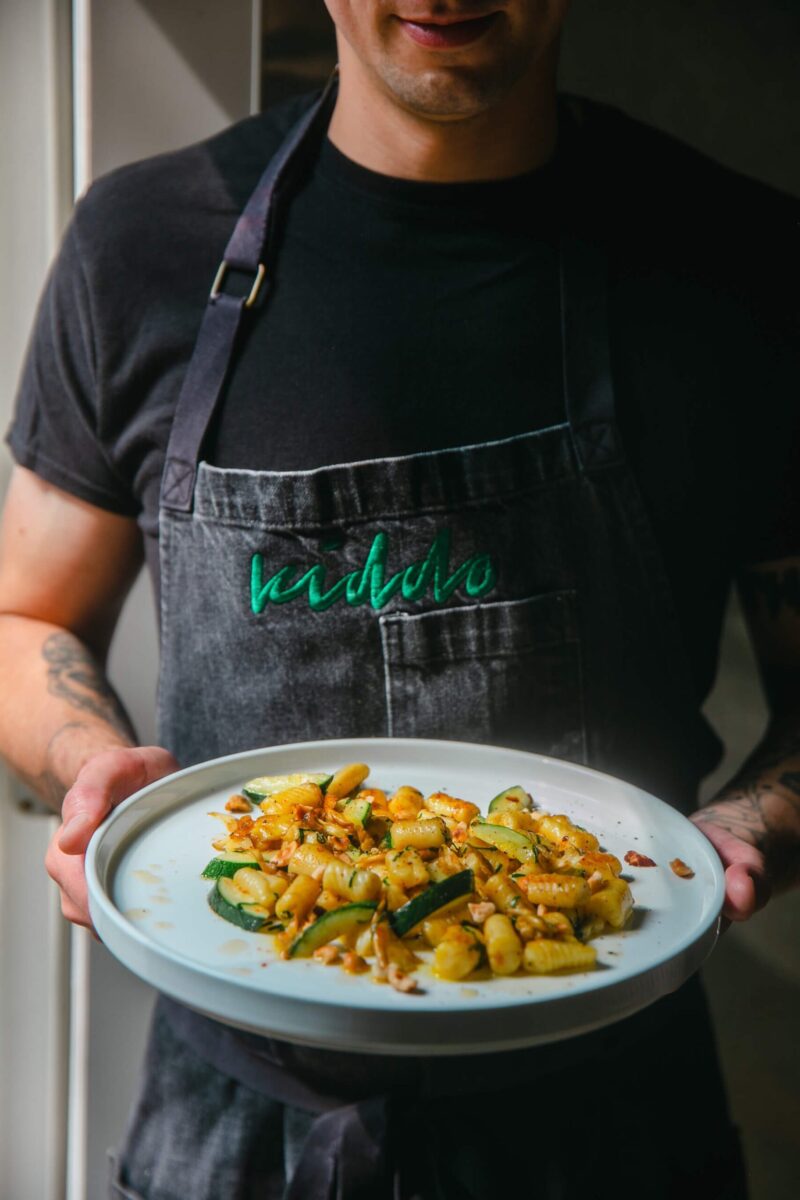Chef Wyatt Piazza is a restaurateur and the founder of Kiddo, Philadelphia. Blending his training in French cuisine at the Culinary Institute of America with his experience working in Sonoma Valley, and his traditional Italian-American upbringing, he brings a vegetable-forward approach to the kitchen that has won Kiddo accolades as ‘One of Philadelphia’s Best New Restaurants.’
| All products featured on The Wellness Feed are independently selected by our editors for its environmental and ethical impact. However, when you buy something through our retail links, we may earn an affiliate commission. |
The best orange juice you’ll ever have is freshly squeezed. The sweet nectar filling your cup from a juice pressed minutes before is a sip of heaven compared to what you’ll find in a refrigerated and store-bought version. For those who don’t own a citrus press, you can visit the corner of a tree-lined street in Washington Square West, to find Kiddo. On any given Saturday or Sunday morning, the restaurant serves vibrant omelets laced with locally sourced veggies, handmade bread topped with Jersey-fresh berries, and of course a fresh glass of orange juice. It’s a plant-forward restaurant that curates a selection of fresh dishes like these that highlight the flavors of its star produce. And that produce you’ll notice is used throughout the menu. The fresh cup of orange juice that you tasted in the morning will be used for a reduction for fish served in the evening. According to Wyatt Piazza, the head chef and co-founder of Kiddo, this circular approach is 100% intentional.
Buzzword Breakdown: What’s That Circular Thing I Keep Hearing About?
“‘Steward of the environment’, that’s what I really believe a chef’s job is,” Wyatt explains the ethos behind his approach in the kitchen. “We need to protect the environment.” This philosophy influences his decisions when choosing what and how to use certain foods on his menu. Most items, including sauces and juices, are made in-house. When a farm offers a surplus of a particular item, his kitchen will look to fermenting or drying as a way to preserve and use what they have. “I bought like a hundred pounds of peppers from this farmer and we smoked, roasted, and then fermented them for like about 10 to 12 days. And then we like made a sauce out of them.” The difference can not only be seen in the minimal amount of food waste from his kitchen but also in the freshness of the meals that are served to hungry customers.
5 Science-Backed Reasons Vegan Meals Are Good For The Planet
Wyatt’s motto and his restaurant’s fresh offerings have garnered the attention of critics, landing Kiddo on the list of ‘Ten Best Restaurants In The U.S. You Need To Try In 2014.’ As a restaurant that indulges in the deliciousness of plants, circular initiatives, and seasonal produce, it’s always rewarding to know that sustainability and good taste can go hand-in-hand. To elaborate on how his kitchen does it all, Wyatt answers a few questions for The Wellness Feed.

How did the planning begin to make the restaurant sustainable?
A lot of planning for this because my wife, Elizabeth Drake, works in the sustainability world. She’s the Director of Sustainability for Swarthmore College. So, partnering with her to plan how we were going to do it here, it took us a while to really think about it because restaurants are inherently unsustainable.
Can France’s Zero Food Waste Law Inspire The U.S. To Adopt Food Waste Solutions?
We started first with waste streams. Like, okay, how are we getting rid of our trash? So I kinda asked Elizabeth, “Hey, what do you guys use at Swarthmore?” Because, I know like they’re on the forefront of that. They’re gonna be neutral by, I think, 2030, I believe, or 2035, so they use the trash company JP Mascaro, who recycle a lot of stuff that other people can’t. The first thing on my list was to compost food waste. So, we partner with Circle Compost. Additionally, we use a service that picks up our spent cooking oil and they make biofuel out of it.
There are trade-offs. If you really dive into it too, another big thing is electricity consumption in restaurants. We use it consciously; mitigating it through certain processes. For instance, a lot of our bread is made by hand. The focaccia we give our guests at dinner time never hits a mixer or anything like that.
So there are certain ways you can kind of try to save a little bit on electricity. Other ways that we’re sustainable too are just sharing between the bar and the kitchen. For instance, we have a black raspberry drink. So, we take the pulp and make a jam for our cookies. And, we make a reduction used for a fish sauce from the oranges used in the orange juice. We use every part of everything.

What challenges have you experienced in the kitchen in terms of sustainability?
The one thing that breaks my heart is the bar program. We try our best. But to a certain extent, you have to get stuff that people want to buy [the name brands]. We do try to use partners that are the most sustainable. Our mezcal comes from a co-op in Mexico. When we’re not using something that’s directly local, we try to find the best people to partner with.
Wine sourcing was much better. All of the wines on our list practice sustainability in different ways. I really don’t want to be supporting people who aren’t practicing that. There’s one or two wines from South Africa that are growing native species of grapes- species of grapes that do super well in that climate. They don’t need as much water or pesticides. We also partner with some people in the Pacific Northwest and in California that do a good job. The coolest one we have is a natural rosé from Australia. I like to use the term ‘natural’ when I’m looking at the ingredients. It’s the same way we approach our food. We’re very straightforward here.
Do you partner with a lot of local farmers?
My next thing my favorite thing is the sourcing. What and how are we gonna get stuff? So, if you eat here for brunch, you’re eating eggs from a ranch called Horseshoe Ranch in Potsdam. The egg yolks are super bright orange. That’s just one example of the many purveyors that we partner with. Most of our food is purchased directly from the farmers of New Jersey and Pennsylvania. For fish and meat I really only choose fish that are wild caught off the coast here. There are some farmed options that have better choices than wild options, for instance, the Arctic char we use, we cure it on one of our brunch dishes. Just having the knowledge to make the best choices is one of the reasons that we don’t really serve red meat here.


What is one thing that you’re really proud of at Kiddo?
For me, we just really try to get good products that don’t require a lot of manipulation and crazy stuff. There’s a pumpkin dish that is basically just a pumpkin served on a plate. It’s been roasted with some herbs and stuff on top of it. But, at the end of the day, it’s just a pumpkin. The reason why that dish succeeds is because we get very good pumpkins from Lancaster County and we treat them well when they get here. That’s kind of what I always talk about with the crew. Product first, then technique. We always want to think first about where can we get the best product. Then we’ll think about applying our knowledge experience and technique to it. That’s how a lot of food dishes started. You look back at the way that all these different cuisines started with products.

